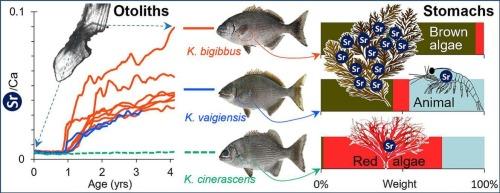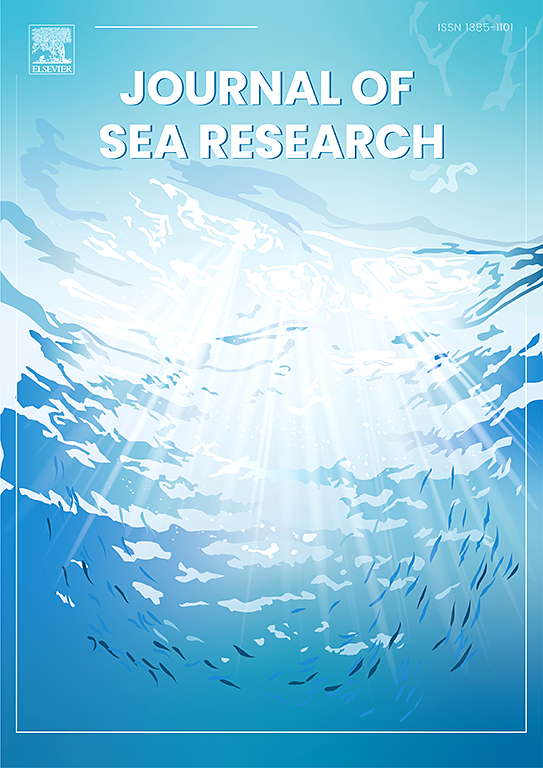草食性鱼类耳石Sr:Ca比值作为褐藻摄食史指标的潜在应用
IF 2.9
4区 地球科学
Q2 MARINE & FRESHWATER BIOLOGY
引用次数: 0
摘要
褐藻(Phaeophyceae)是海洋藻类中最大和最重要的生态类群,是海岸带生态系统的栖息地形成生物。了解草食性鱼类对褐藻的摄食压力,对于阐明珊瑚礁和藻林的动态至关重要。本研究的重点是褐藻积累锶(Sr)的独特能力,并验证了经常食用褐藻会提高草食性鱼类耳石Sr:钙(Ca)比率的假设。我们分析了在日本西南部收集的四种同域物种的胃内容物和耳石Sr:Ca比值。在三种棘足动物中,较高的Sr:Ca比值与褐藻消费频率有关。值得注意的是,褐藻专家K. bigibbus显示出异常高的耳石Sr:Ca比值(0.12),远远超过海洋鱼类的常见范围(0.004-0.02)。在经常食用褐藻的地区,威氏库蚊的Sr:Ca比值很高,而在主要食用红藻的地区,Sr:Ca比值适中。而在cinerascens中,只观察到后一种模式。这两种模式都符合我们的假设。此外,研究结果还表明,大圆叶蝉在大约1岁时开始以褐藻为食。相比之下,尽管经常以褐藻为食,但fuscesensis的Sr:Ca比值在正常范围内,偏离了这一假设。因此,耳石Sr:Ca比值可以作为重建褐藻摄食历史的物种特异性代理,为研究长寿物种几十年来的食草性提供了一种新的工具。本文章由计算机程序翻译,如有差异,请以英文原文为准。

Potential application of otolith Sr:Ca ratios as indicators of brown-algae feeding histories in herbivorous fishes
Brown algae (Phaeophyceae) are the largest and most ecologically important group of marine algae, serving as habitat-forming organisms shaping coastal ecosystems. Understanding the feeding pressure exerted by herbivorous fishes on brown algae is essential for elucidating the dynamics of both coral reefs and algal forests. This study focused on the unique ability of brown algae to accumulate strontium (Sr) and tested the hypothesis that frequent consumption of brown algae elevates otolith Sr:calcium (Ca) ratios in herbivorous fishes. We analysed stomach contents and otolith Sr:Ca ratios in four sympatric species collected in southwestern Japan. Among three Kyphosus species, higher Sr:Ca ratios were associated with the frequency of brown-algae consumption. Notably, K. bigibbus, a brown-algae specialist, exhibited an exceptionally high otolith Sr:Ca ratio (0.12), far exceeding the common range of marine fishes (0.004–0.02). In K. vaigiensis, Sr:Ca ratios were high in areas where brown algae were frequently consumed, whereas they were moderate in areas where red algae were predominantly consumed. In K. cinerascens, only the latter pattern was observed. Both patterns are consistent with our hypothesis. Furthermore, the results suggest that K. bigibbus begin feeding on brown algae at approximately 1 year of age. By contrast, Siganus fuscescens exhibited Sr:Ca ratios within the common range, despite frequent feeding on brown algae, deviating from this hypothesis. Therefore, otolith Sr:Ca ratios may serve as a species-specific proxy for reconstructing feeding histories on brown algae, providing a novel tool for investigating herbivory over several decades in long-lived species.
求助全文
通过发布文献求助,成功后即可免费获取论文全文。
去求助
来源期刊

Journal of Sea Research
地学-海洋学
CiteScore
3.20
自引率
5.00%
发文量
86
审稿时长
6-12 weeks
期刊介绍:
The Journal of Sea Research is an international and multidisciplinary periodical on marine research, with an emphasis on the functioning of marine ecosystems in coastal and shelf seas, including intertidal, estuarine and brackish environments. As several subdisciplines add to this aim, manuscripts are welcome from the fields of marine biology, marine chemistry, marine sedimentology and physical oceanography, provided they add to the understanding of ecosystem processes.
 求助内容:
求助内容: 应助结果提醒方式:
应助结果提醒方式:


